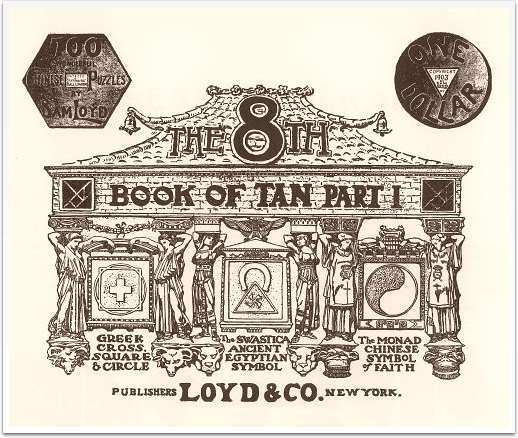The 8th Book of Tan by Sam Loyd
According to encyclopædia lore, the game of Tangrams is of very ancient origin, and has been played in China for upward of 4,000 years, somewhat in the nature of a national pastime. It consists of seven flat pieces of wood, cut upon the geometrical angles of 45 and 90 degrees, with straight edges which fit together so as to produce a variety of changes which baffles the science of mathematics to compute .
Webster's dictionary merely mentions Tangrams as being used in primary schools for elementary kindergarten instruction. According to one authority, ''the simple shapes are eminently suitable for illustrating a limited number of plane geometrical figures.''
The aim of this work is to show the unlimited range of those possibilities, and to explain, in the language of truthful James:
"Which I wish to remark
And my language is plain
That for ways that are dark
And for tricks that are vain,
The heathen Chinee is peculiar :
Which the same I would rise to explain."
There are so many popular editions printed in puzzle-book form that it is safe to say that it is known throughout the entire world as a very simple little pastime, suitable for the juveniles. Through that unfortunate misconception of the scope of the science, as it should be termed, it has failed to be properly appreciated .
The finest figures have been thrown out as impossible of construction, and the important and fascinating feature of originating new designs entirely omitted .

In this feeble attempt to do justice to the grandeur of the original conception, it must be understood that each and every one of the illustrations requires a complete set of Tangrams. It constitutes, therefore, a unique collection of puzzles, wherein the object is to guess the names of the subjects; to discover their construction and penetrate the mysteries which surround them, as well as to originate new and artistic designs with the same limited number of pieces.

At first we are amazed at the unfitness of the shapes of the pieces with which we are expected to accomplish so much. The number seven is an obstinate prime which cannot be devided into symmetrical halves; and the geometrical forms, all alike, with harsh angles, preclude the possibility of variety, curves, or graceful lines.
Many puzzlists have invented cut-up pictures, where twenty or more pieces are to be put together to make some form, which is not so unique as many of these. No genius has ever been able to make a good puzzle where pieces refit together, so as to make a second object, and yet here are only seven angular pieces, which, without any omissions, duplications or lapping of edges, give free rein to the imagination, to produce ten thousand different designs.

According to the late Professor Challenor, whose posthumous papers have come into the possession of the writer, seven books of Tangrams, containing one thousand designs each, are known to have been compiled in China over 4,000 years ago. These books are so rare that Professor Challenor says that during a forty years' residence in China he only succeeded in seeing perfect editions of the first and seventh volumes, with stray fragments of the second. In this connection it may be mentioned that portions of one of the books, printed in gold-leaf upon parchment, were found in Pekin by an English soldier and sold for £300 to a collector of Chinese antiquities, who kindly furnished some of the choicest designs presented in this work. According to Professor Challenor, the many specimens of Tangrams which have been published from time to time in small volumes, in the form of well-known collections, are extracts from what might be termed Chinese catechisms, designed to elucidate the different features of the original works. Of these small books there are about twenty varieties, limited, however, to a selection of the poorest and less important subjects, after the following symmetrical style, as the publishers merely present them in the nature of juvenile puzzles.


